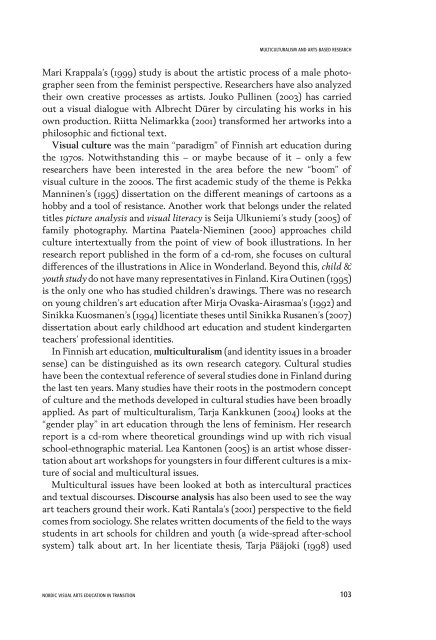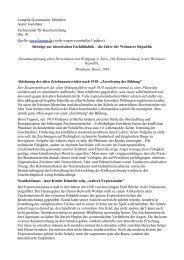Research in Visual Arts Education - The National Society for ...
Research in Visual Arts Education - The National Society for ...
Research in Visual Arts Education - The National Society for ...
Create successful ePaper yourself
Turn your PDF publications into a flip-book with our unique Google optimized e-Paper software.
MULTICULTURALISM AND ARTS-BASED RESEARCH<br />
Mari Krappala’s (1999) study is about the artistic process of a male photographer<br />
seen from the fem<strong>in</strong>ist perspective. <strong>Research</strong>ers have also analyzed<br />
their own creative processes as artists. Jouko Pull<strong>in</strong>en (2003) has carried<br />
out a visual dialogue with Albrecht Dürer by circulat<strong>in</strong>g his works <strong>in</strong> his<br />
own production. Riitta Nelimarkka (2001) trans<strong>for</strong>med her artworks <strong>in</strong>to a<br />
philosophic and fictional text.<br />
<strong>Visual</strong> culture was the ma<strong>in</strong> “paradigm” of F<strong>in</strong>nish art education dur<strong>in</strong>g<br />
the 1970s. Notwithstand<strong>in</strong>g this – or maybe because of it – only a few<br />
researchers have been <strong>in</strong>terested <strong>in</strong> the area be<strong>for</strong>e the new “boom” of<br />
visual culture <strong>in</strong> the 2000s. <strong>The</strong> first academic study of the theme is Pekka<br />
Mann<strong>in</strong>en’s (1995) dissertation on the different mean<strong>in</strong>gs of cartoons as a<br />
hobby and a tool of resistance. Another work that belongs under the related<br />
titles picture analysis and visual literacy is Seija Ulkuniemi’s study (2005) of<br />
family photography. Mart<strong>in</strong>a Paatela-Niem<strong>in</strong>en (2000) approaches child<br />
culture <strong>in</strong>tertextually from the po<strong>in</strong>t of view of book illustrations. In her<br />
research report published <strong>in</strong> the <strong>for</strong>m of a cd-rom, she focuses on cultural<br />
differences of the illustrations <strong>in</strong> Alice <strong>in</strong> Wonderland. Beyond this, child &<br />
youth study do not have many representatives <strong>in</strong> F<strong>in</strong>land. Kira Out<strong>in</strong>en (1995)<br />
is the only one who has studied children’s draw<strong>in</strong>gs. <strong>The</strong>re was no research<br />
on young children’s art education after Mirja Ovaska-Airasmaa’s (1992) and<br />
S<strong>in</strong>ikka Kuosmanen’s (1994) licentiate theses until S<strong>in</strong>ikka Rusanen’s (2007)<br />
dissertation about early childhood art education and student k<strong>in</strong>dergarten<br />
teachers’ professional identities.<br />
In F<strong>in</strong>nish art education, multiculturalism (and identity issues <strong>in</strong> a broader<br />
sense) can be dist<strong>in</strong>guished as its own research category. Cultural studies<br />
have been the contextual reference of several studies done <strong>in</strong> F<strong>in</strong>land dur<strong>in</strong>g<br />
the last ten years. Many studies have their roots <strong>in</strong> the postmodern concept<br />
of culture and the methods developed <strong>in</strong> cultural studies have been broadly<br />
applied. As part of multiculturalism, Tarja Kankkunen (2004) looks at the<br />
“gender play” <strong>in</strong> art education through the lens of fem<strong>in</strong>ism. Her research<br />
report is a cd-rom where theoretical ground<strong>in</strong>gs w<strong>in</strong>d up with rich visual<br />
school-ethnographic material. Lea Kantonen (2005) is an artist whose dissertation<br />
about art workshops <strong>for</strong> youngsters <strong>in</strong> four different cultures is a mixture<br />
of social and multicultural issues.<br />
Multicultural issues have been looked at both as <strong>in</strong>tercultural practices<br />
and textual discourses. Discourse analysis has also been used to see the way<br />
art teachers ground their work. Kati Rantala’s (2001) perspective to the field<br />
comes from sociology. She relates written documents of the field to the ways<br />
students <strong>in</strong> art schools <strong>for</strong> children and youth (a wide-spread after-school<br />
system) talk about art. In her licentiate thesis, Tarja Pääjoki (1998) used<br />
NORDIC VISUAL ARTS EDUCATION IN TRANSITION 103



